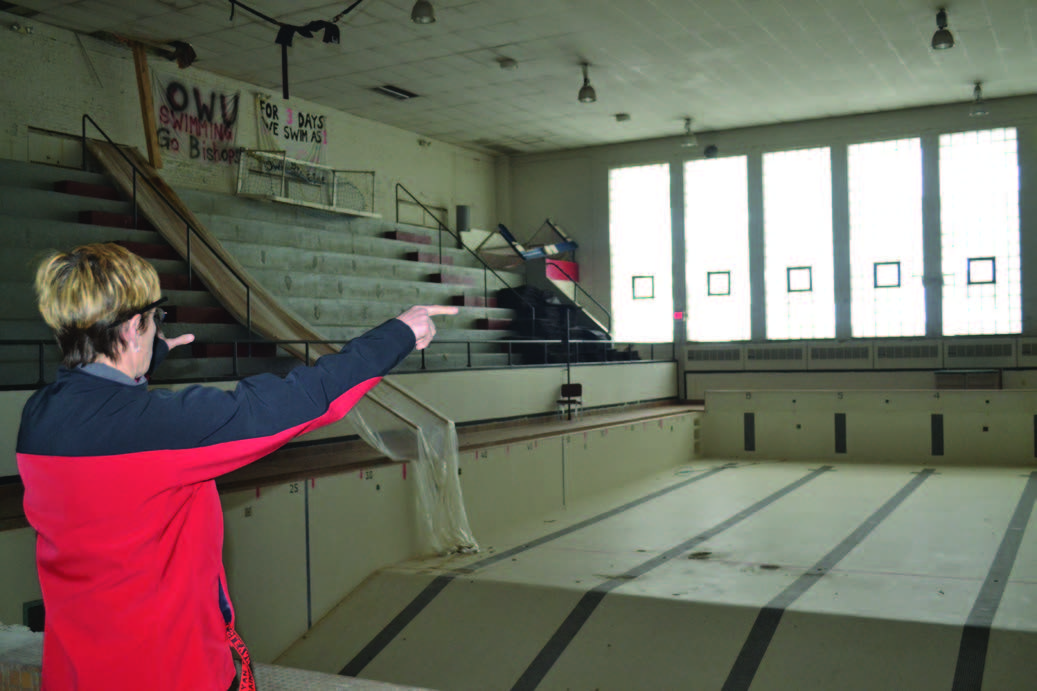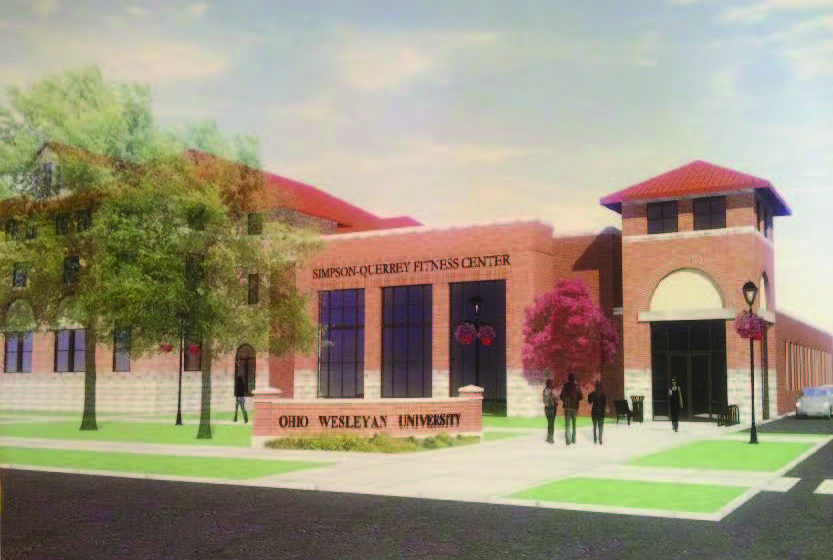
Photo by Breanne Reilly
By Breanne Reilly
Transcript Reporter
The building formerly known as Pfeiffer Natatorium will get an extreme makeover thanks to a donation by Lou Simpson, ‘58, and his wife Kimberly Querrey.
The donation will be used to build the Simpson-Querrey Fitness Center, the new Dance Studio, finish renovations of Edwards Gym and renovate offices, classrooms and the studio used by the Health and Human Kinetics (HHK) department.
In a press release, Jones said Querrey was motivated by the fact that nearly 80 percent of OWU students participate in organized recreational activities, such as intramurals, club sports and varsity athletics.
Jones said it is important to give students a space to develop disciplines that lead to healthy living.
“A fitness center increasingly is a must for college campuses, as prospective students include this in the things they consider when selecting a college,” Jones said.
Sean Kay, professor in the department of politics and government, said all donations are to be appreciated, valued and celebrated but do not always pay for necessities.
“In my own personal opinion, gifts like this and the one last summer for Merrick Hall, are very welcome and appropriate on their own merits,” Kay said.
“At the same time they are not oriented towards the major needs and priorities of the institution as have been identified in the strategic planning process that I have been engaged in on and off dating back to 2005.”
Kay said he thinks the new Fitness Center, although appreciated, is not a top priority for the university.
He thinks the YMCA in town could be utilized and perhaps negotiated for a low cost for student use.
“So far as I can tell, there seems to be a heavy focus on funding ancillary priorities, but not really focusing on the core foundations of further building Ohio Wesleyan University as the top level liberal arts institution we all know it is, and can even be more so, with a diverse range of endowment investments focused on the long-established academic program,” Kay said.
Kay said he thinks investment should be placed in the liberal arts curriculum, and in hiring and retaining the “top notch” faculty, the academic program and in developing the highest quality classroom experience that we can give our students.
He said the focus should also be on lowering costs to students.
Jones said the $8 million donation is being used as its donors intended.

“This gift was specifically for the fitness center and the renovation of Edwards Gym,” Jones said.
Jones said the renovations and construction of the facilities will not affect and did not cause an increase in tuition.
“The tuition increase reflects the increasing cost of operating the university, including paying salaries of faculty and staff, addressing increasing energy costs and meeting other needs,” Jones said.
Part of a Plan
Jones said renovations were approved in 2009, when the Strategic Plan of Ohio Wesleyan called for construction of a Fitness Center on the residential campus.
In 2011, the Board began discussing and reviewing concepts for the Fitness Center, and the idea developed to integrate the Fitness Center with the Dance Studio, Health and Human Kinetics and the restoration of Edwards Gym.
The Board also committed the plan would include the purchase of new equipment for the Belt Fitness Center.
Jones said he does not have a breakdown in regards to how much of the $8 million donation each part of the construction will cost.
He said The Collaborative Inc., located in Toledo, came up with the renovation designs as seen on the OWU website.
TCI is developing a final schedule for the construction and will most likely work on each component of the renovations simultaneously.
All construction on the building will be finished within 15 to 20 months.
Jones said the administration and Board have a commitment to the university’s history by preserving the buildings that will be renovated.
“It also allows us to address needs in the academic department which currently is housed in the poorest conditions for offices and classrooms on campus,” he said. “This is very important for HHK.”
Renovating Pfeiffer, the “Tenement
Building”
“When it would rain, the ceiling tiles would get saturated and tiles would fall down,” Nancy Knop, a professor in the Health and Human Kinetics department said. “It’s the campus tenement building.”
Pfeffeir Natatorium, which is attached physically to Edwards Hall but cannot be entered through Edwards, houses the HHK offices and classes.
Before Meek was built three years ago, it also housed the campus pool. But the pool is now empty, the ceiling and floors are missing tiles, multiple windows are boarded and broken, the roof leaks and the water, which is a musty yellow, is not usable.
Senior Andrew Diehl, co-chair of the HHK student board said the conditions are a distraction.
He said the conditions are little known on campus because students who don’t take the classes have no reason to go there now that the pool is gone.
“HHK is like the fourth or fifth largest department on campus,” Diehl said. “But it has the worst facility. It’s by far the most neglected building on campus,” he said.
Knop said the building has needed repairs for years and the department has spent ten years trying to get funding from the Board of Trustees. She said initially renovations to the classrooms, offices and workout studio were not a part of the Plan.
“We as an academic program have been ignored for years,” Knop said. “If a student has been paying $50,000 to go to school do you want him sitting in a classroom where the ceiling tiles fall down and there’s no hot water and where you can’t drink the water in the building and that it’s freezing cold and the windows are broken and when it rains water comes into it?”
The swimming pool, now located at Meek, was the first to be reconstructed.
Knop said the pool was chosen partially for health reasons.
“I don’t know how well it’s documented but I can assume that most of the swimmers had exercise induced asthma because of the chemicals and lack of ventilation,” Knop said.
Knop said when discussion for renovations started ten years ago, the focus for renovations was on the Dance Studio and the Fitness Center.
“The bringing in of those facilities was a little bit hurtful at first because here we are living in these terrible facilities and conditions and they’re worried about dance, which didn’t even have a program at the time,” she said.
Knop said she is thrilled that the renovations are taking place. When she found out the Dance Studio would be built next to the new Fitness Center, Knop said she was glad that the Dance department gets a new facility but she is not thrilled that it will be located inside of the athletic facility.
“It felt bad to have people looking at a space that we thought could’ve been our space in our building,” she said.
Knop said a new building is needed to improve the appeal of the department and so that the building can be used as an attractive entryway to campus.
“That was kind of the image, the vision, to make something that was more regal, versus something that is just linked to athletics,” she said.
As of right now, Pfeiffer Natatorium is not shown to prospective touring students. Diehl said it might discourage prospective students from taking classes there.
“It’s an eyesore, the university doesn’t advertise it,” Diehl said.
Knop said the department could be asked to move as early as May so the renovations can start next fall. She does not know where the classes will be relocated during construction but hopes the location will allow students to move during lessons.
“We run one to two classes almost every hour so will have to find space to accommodate that,” she said.
A Dance Studio with Dancers in Mind
Jones said the possibility of a new dance studio being built was discussed more than a decade ago. Jones also said faculty in Theater and Dance department and in Health and Human Kinetics have engaged with architects in planning for this facility.
Rashana Smith, who instructs dance classes in a leased facility on 38 S. Sandusky St. said she and the dance students appreciate the studio but the current space was not built with dancers in mind and she has had to adjust her classes because of it.
“I spend more time on conditioning and stretching to counteract joint strain caused from dancing on a hard, unsprung floor,” she said.
“The newly renovated Simpson Querrey facility would accommodate more jumping and leaping, for example, because the construction of the new floor will address the impact of landings and the physical demands of dance.”
She also said the heating system in the downtown studio has not been able to heat the studio.
“ Several times this semester, we’ve had to find alternate places and creative ways to deal with an extremely cold dance studio,” Smith said.
Smith said she hopes the new dance studio would attract more prospective dance students and likely more dance minors and non-majors.
“Historically, we have students from different academic disciplines participating in classes and performances,” she said.
“I see the new studio bolstering that participation.”
Jones said the Dance Studio will accommodate the theatre and dance program and attract prospective students.